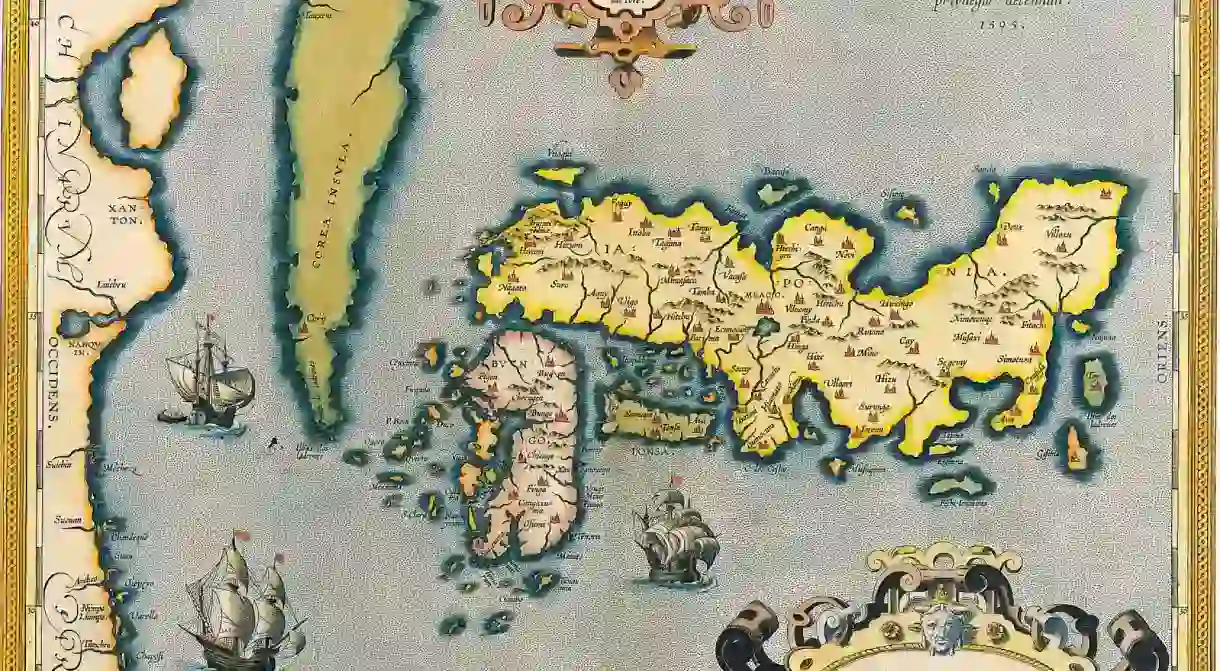Where Does Japan’s Name Come From?

In the native language, it’s 日本, ‘Nihon’, or ‘Nippon’. In English, it’s ‘Japan’. And in other languages, it’s some variation of the same: Japon, Iapan, Giappone, Япония (Yaponiya), 일본 (Il-bon), Rìběn, Yahtbún, Zeppen, Nhật Bản. But before it was any of these, Japan was known as 倭国 (‘Wakoku’).
Oyashima, the ‘Eight Islands’
Japan was a spoken language long before it was a written one, so it’s not clear what the earliest people of Japan called themselves. The Kojiki (‘Record of Ancient Matters’), written 711-712 CE, is the oldest Japanese text in existence and tells the mythical creation story of Japan. It was written in classical Japanese, a writing system made by pairing Chinese characters with Japanese sounds.

The Kojiki describes the birth of a land called ‘Oyashima’, or the ‘Eight Great Islands’, referring to modern-day Honshu, Shikoku, and Kyushu (Hokkaido and Okinawa were not considered part of Japan in ancient times). However, it’s unclear whether the name ‘Oyashima’ was ever used by Japan’s prehistoric people or if the name was simply applied later. That’s because, by the 8th century when the Kojiki was written, Japan was already going by the name of ‘Wakoku’ (倭国).
The People of ‘Wa’
‘Wa’ (倭) was the name given to the people whom the ancient Chinese encountered living in the southern area of Japan. The earliest reference to these people can be found in Chinese court documents hundreds of years before the Kojiki was written. These records mention that Han Dynasty Emperor Guangwu gave a golden seal to the first Japanese envoy to visit China in 57 CE. Now a national treasure of Japan, the seal is inscribed with text that roughly translates to ‘King of Na, Land of Wa, vassal to Han Dynasty’.

It’s uncertain why the ancient Chinese decided to call Japan ‘Wakoku’ (倭国), or the ‘Land of Wa’. One theory is that the traditional Japanese words for ‘I’ and ‘we’ are ‘waga’ (我が) and ‘ware’ (我), so the Chinese decided that must mean the people they encountered there were the Wa people.
The Yamato Kingdom
The Na Kingdom wasn’t the only one in ancient Japan. Before Japan was one country, it was several ancient provinces. The largest group of native Japanese were the Yamato, who lived in modern-day Honshu, and in the 6th century they established an imperial court in Nara modeled after the Chinese court. The Yamato adopted the character for ‘Wa’ (倭) and used it to write the name ‘Yamato’ (大倭).
Why Japan is called the ‘Land of the Rising Sun’
Around the 7th or 8th century, Japan’s name changed from ‘Wakoku’ (倭国) to ‘Nihon’ (日本). Some records say that the Japanese envoy to China requested to change the name because he disliked it; other records say that the Chinese Empress Wu Zetian ordered Japan to change its name. Either way, Wakoku became Nihon (sometimes pronounced ‘Nippon’).
The kanji for ‘Nihon’ (日本) literally means ‘origin of the sun’, referring to the fact that Japan is located east of China and appeared to be the place from which the sun rose. This tied in pretty conveniently with Japan’s origin story, as the sun goddess Amaterasu holds an important place in Japanese mythology.

The reason the Japanese became dissatisfied with the character for ‘Wa’ (倭) around this time was that the kanji had some negative connotations, including subservient, kneeling, and — interestingly enough — dwarf.
The Yamato people decided that they didn’t care for the symbol ‘Wa’ (倭) anymore and opted to change it to ‘Wa’ (和) meaning ‘peace’, and so ‘Yamato’ (大倭) became ‘Yamato’ (大和). The character for ‘peace’ is still used in modern times to refer to things that are inherently Japanese, including washoku (和食), traditional Japanese food; wagyu, domestic Japanese beef; and washitsu (和室), traditional rooms with tatami mats.
Jipangu and Japan
So how did the Yamato people get from ‘Nihon’ to ‘Japan’?
Japan was first mentioned as ‘Cipangu’ in the travel diaries of Marco Polo, though whether he actually visited Japan is still up for debate. It’s suspected that the name came from Portuguese, as early Portuguese explorers may have heard ‘日本’ pronounced ‘Cipan’ in northern China and interpreted it as ‘Jipangu’. Similarly, the Dutch may have heard the name ‘Yatbun’ or ‘Yatpun’ in southern China and interpreted it as ‘Ja-pan’, as the letter ‘j’ is pronounced with a ‘y’ sound in Dutch. These two alternative pronunciations for ‘日本’ can still be heard today in Shanghainese (‘Zeppen’) and Cantonese (‘Yahtbún’).













